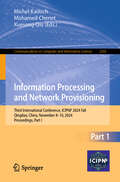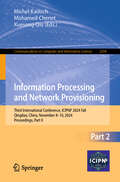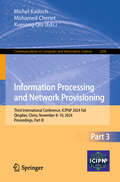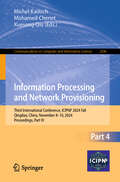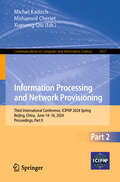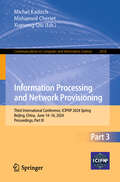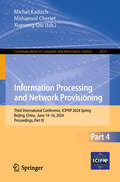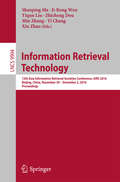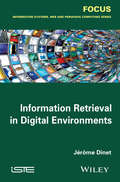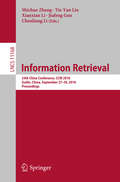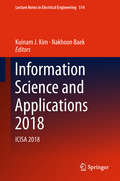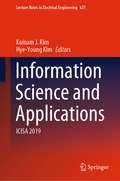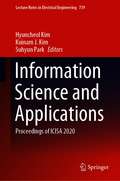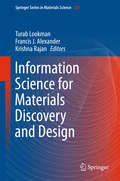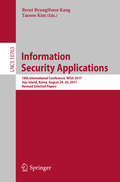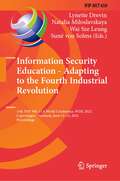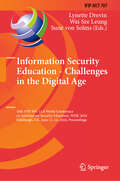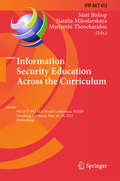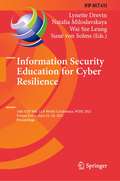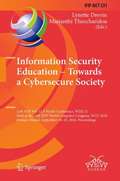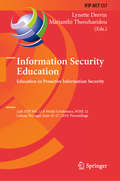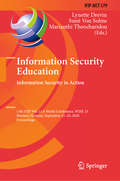- Table View
- List View
Information Processing and Network Provisioning: Third International Conference, ICIPNP 2024 Fall, Qingdao, China, November 8–10, 2024, Proceedings, Part I (Communications in Computer and Information Science #2593)
by Xuesong Qiu Michel Kadoch Mohamed CherietThe proceedings set CCIS 2593 until CCIS 2596 constitutes the proceedings of the Third International Conference on Information Processing and Network Provisioning, ICIPNP 2024, which took place in Qingdao, China, during November 8-10, 2024. The 153 full papers presented in the proceedings were carefully reviewed and selected from 277 submissions. They deal with up to date research ranging from information and signal processing and network provisioning to computer communications and network applications.
Information Processing and Network Provisioning: Third International Conference, ICIPNP 2024 Fall, Qingdao, China, November 8–10, 2024, Proceedings, Part II (Communications in Computer and Information Science #2594)
by Xuesong Qiu Michel Kadoch Mohamed CherietThe proceedings set CCIS 2593 until CCIS 2596 constitutes the proceedings of the Third International Conference on Information Processing and Network Provisioning, ICIPNP 2024, which took place in Qingdao, China, during November 8-10, 2024. The 153 full papers presented in the proceedings were carefully reviewed and selected from 277 submissions. They deal with up to date research ranging from information and signal processing and network provisioning to computer communications and network applications.
Information Processing and Network Provisioning: Third International Conference, ICIPNP 2024 Fall, Qingdao, China, November 8–10, 2024, Proceedings, Part III (Communications in Computer and Information Science #2595)
by Xuesong Qiu Michel Kadoch Mohamed CherietThe proceedings set CCIS 2593 until CCIS 2596 constitutes the proceedings of the Third International Conference on Information Processing and Network Provisioning, ICIPNP 2024, which took place in Qingdao, China, during November 8-10, 2024. The 153 full papers presented in the proceedings were carefully reviewed and selected from 277 submissions. They deal with up to date research ranging from information and signal processing and network provisioning to computer communications and network applications.
Information Processing and Network Provisioning: Third International Conference, ICIPNP 2024 Fall, Qingdao, China, November 8–10, 2024, Proceedings, Part IV (Communications in Computer and Information Science #2596)
by Xuesong Qiu Michel Kadoch Mohamed CherietThe proceedings set CCIS 2593 until CCIS 2596 constitutes the proceedings of the Third International Conference on Information Processing and Network Provisioning, ICIPNP 2024, which took place in Qingdao, China, during November 8-10, 2024. The 153 full papers presented in the proceedings were carefully reviewed and selected from 277 submissions. They deal with up to date research ranging from information and signal processing and network provisioning to computer communications and network applications.
Information Processing and Network Provisioning: Third International Conference, ICIPNP 2024 Spring, Beijing, China, June 14–16, 2024, Proceedings, Part I (Communications in Computer and Information Science #2416)
by Xuesong Qiu Michel Kadoch Mohamed CherietThe four-volume set CCIS 2416, 2417, 2418 and 2419 constitutes the refereed post-conference proceedings of the Third International Conference on Information Processing and Network Provisioning, ICIPNP 2024 Spring, held in Beijing, China, during June 14–16, 2024. The 152 revised full papers presented in these proceedings were carefully reviewed and selected from 347 submissions. They focus on topics ranging from 5G/6G evolution and AI in network optimization to quantum communication and green computing.
Information Processing and Network Provisioning: Third International Conference, ICIPNP 2024 Spring, Beijing, China, June 14–16, 2024, Proceedings, Part II (Communications in Computer and Information Science #2417)
by Xuesong Qiu Michel Kadoch Mohamed CherietThe four-volume set CCIS 2416, 2417, 2418 and 2419 constitutes the refereed post-conference proceedings of the Third International Conference on Information Processing and Network Provisioning, ICIPNP 2024 Spring, held in Beijing, China, during June 14–16, 2024. The 152 revised full papers presented in these proceedings were carefully reviewed and selected from 347 submissions. They focus on topics ranging from 5G/6G evolution and AI in network optimization to quantum communication and green computing.
Information Processing and Network Provisioning: Third International Conference, ICIPNP 2024 Spring, Beijing, China, June 14–16, 2024, Proceedings, Part III (Communications in Computer and Information Science #2418)
by Xuesong Qiu Michel Kadoch Mohamed CherietThe four-volume set CCIS 2416, 2417, 2418 and 2419 constitutes the refereed post-conference proceedings of the Third International Conference on Information Processing and Network Provisioning, ICIPNP 2024 Spring, held in Beijing, China, during June 14–16, 2024. The 152 revised full papers presented in these proceedings were carefully reviewed and selected from 347 submissions. They focus on topics ranging from 5G/6G evolution and AI in network optimization to quantum communication and green computing.
Information Processing and Network Provisioning: Third International Conference, ICIPNP 2024 Spring, Beijing, China, June 14–16, 2024, Proceedings, Part IV (Communications in Computer and Information Science #2419)
by Xuesong Qiu Michel Kadoch Mohamed CherietThe four-volume set CCIS 2416, 2417, 2418 & 2419 constitutes the refereed post-conference proceedings of the Third International Conference on Information Processing and Network Provisioning, ICIPNP 2024 Spring, held in Beijing, China, during June 14–16, 2024. The 152 revised full papers presented in these proceedings were carefully reviewed and selected from 347 submissions. They focus on topics ranging from 5G/6G evolution and AI in network optimization to quantum communication and green computing.
Information Retrieval Technology
by Min Zhang Shaoping Ma Ji-Rong Wen Yiqun Liu Zhicheng Dou Yi Chang Xin ZhaoThis book constitutes the refereed proceedings of the 9th Information Retrieval Societies Conference, AIRS 2013, held in Singapore, in December 2013. The 27 full papers and 18 poster presentations included in this volume were carefully reviewed and selected from 109 submissions. They are organized in the following topical sections: IR theory, modeling and query processing; clustering, classification and detection; natural language processing for IR; social networks, user-centered studies and personalization and applications.
Information Retrieval in Digital Environments
by Jerome DinetInformation retrieval is a central and essential activity. It is indeed difficult to find a human activity that does not need to retrieve information in an environment which is often increasingly digital: moving and navigating, learning, having fun, communicating, informing, making a decision, etc. Most human activities are intimately linked to our ability to search quickly and effectively for relevant information, the stakes are sometimes extremely important: passing an exam, voting, finding a job, remaining autonomous, being socially connected, developing a critical spirit, or simply surviving. The author of this book presents a summary of work undertaken over several years relative to the behaviors and cognitive processes involved in information retrieval in digital environments. He presents several examples of theoretical models and studies to better understand the difficulties, behaviors and strategies of individuals searching for information in digital environments.
Information Retrieval: 24th China Conference, Ccir 2018, Guilin, China, September 27-29, 2018. Proceedings (Lecture Notes in Computer Science #11168)
by Tie-Yan Liu Shichao Zhang Xianxian Li Jiafeng Guo Chenliang LiThis book constitutes the refereed proceedings of the 24th China Conference on Information Retrieval, CCIR 2018, held in Guilin, China, in September 2018. The 22 full papers presented were carefully reviewed and selected from 52 submissions. The papers are organized in topical sections: Information retrieval, collaborative and social computing, natural language processing.
Information Science and Applications 2018: ICISA 2018 (Lecture Notes in Electrical Engineering #514)
by Kuinam J. Kim Nakhoon BaekThis book contains selected papers from the 9th International Conference on Information Science and Applications (ICISA 2018) and provides a snapshot of the latest issues encountered in technical convergence and convergences of security technology. It explores how information science is core to most current research, industrial and commercial activities and consists of contributions covering topics including Ubiquitous Computing, Networks and Information Systems, Multimedia and Visualization, Middleware and Operating Systems, Security and Privacy, Data Mining and Artificial Intelligence, Software Engineering, and Web Technology. The proceedings introduce the most recent information technology and ideas, applications and problems related to technology convergence, illustrated through case studies, and reviews converging existing security techniques. Through this volume, readers will gain an understanding of the current state-of-the-art information strategies and technologies of convergence security. The intended readership includes researchers in academia, industry and other research institutes focusing on information science and technology.
Information Science and Applications: ICISA 2019 (Lecture Notes in Electrical Engineering #621)
by Kuinam J. Kim Hye-Young KimThis book presents selected papers from the 10th International Conference on Information Science and Applications (ICISA 2019), held on December 16–18, 2019, in Seoul, Korea, and provides a snapshot of the latest issues regarding technical convergence and convergences of security technologies. It explores how information science is at the core of most current research as well as industrial and commercial activities. The respective chapters cover a broad range of topics, including ubiquitous computing, networks and information systems, multimedia and visualization, middleware and operating systems, security and privacy, data mining and artificial intelligence, software engineering and web technology, as well as applications and problems related to technology convergence, which are reviewed and illustrated with the aid of case studies. Researchers in academia, industry, and at institutes focusing on information science and technology will gain a deeper understanding of the current state of the art in information strategies and technologies for convergence security.
Information Science and Applications: Proceedings of ICISA 2020 (Lecture Notes in Electrical Engineering #739)
by Kuinam J. Kim Hyuncheol Kim Suhyun ParkThis book presents select proceedings of 11th International Conference on Information Science and Applications 2020 (ICISA 2020) and provides a snapshot of the latest issues encountered in technical convergence and convergences of security technology. It explores how information science is core to most current research, industrial and commercial activities and consists of contributions covering topics including Ubiquitous Computing, Networks and Information Systems, Multimedia and Visualization, Middleware and Operating Systems, Security and Privacy, Data Mining and Artificial Intelligence, Software Engineering, and Web Technology. Also the proceedings introduce the most recent information technology and ideas, applications and problems related to technology convergence, illustrated through case studies, and reviews converging existing security techniques. Through this book, readers can gain an understanding of the current state-of-the-art information strategies and technologies of convergence security.
Information Science for Materials Discovery and Design
by Turab Lookman Francis J. Alexander Krishna RajanThis book deals with an information-driven approach to plan materials discovery and design, iterative learning. The authors present contrasting but complementary approaches, such as those based on high throughput calculations, combinatorial experiments or data driven discovery, together with machine-learning methods. Similarly, statistical methods successfully applied in other fields, such as biosciences, are presented. The content spans from materials science to information science to reflect the cross-disciplinary nature of the field. A perspective is presented that offers a paradigm (codesign loop for materials design) to involve iteratively learning from experiments and calculations to develop materials with optimum properties. Such a loop requires the elements of incorporating domain materials knowledge, a database of descriptors (the genes), a surrogate or statistical model developed to predict a given property with uncertainties, performing adaptive experimental design to guide the next experiment or calculation and aspects of high throughput calculations as well as experiments. The book is about manufacturing with the aim to halving the time to discover and design new materials. Accelerating discovery relies on using large databases, computation, and mathematics in the material sciences in a manner similar to the way used to in the Human Genome Initiative. Novel approaches are therefore called to explore the enormous phase space presented by complex materials and processes. To achieve the desired performance gains, a predictive capability is needed to guide experiments and computations in the most fruitful directions by reducing not successful trials. Despite advances in computation and experimental techniques, generating vast arrays of data; without a clear way of linkage to models, the full value of data driven discovery cannot be realized. Hence, along with experimental, theoretical and computational materials science, we need to add a "fourth leg'' to our toolkit to make the "Materials Genome'' a reality, the science of Materials Informatics.
Information Security Applications: 18th International Conference, WISA 2017, Jeju Island, Korea, August 24-26, 2017, Revised Selected Papers (Lecture Notes in Computer Science #10763)
by Brent ByungHoon Kang Taesoo KimThis book constitutes the thoroughly refereed post-conference proceedings of the 18th International Conference on Information Security Applications, WISA 2017, held on Jeju Island, Korea, in August 2017.The 12 revised full papers and 15 short papers presented in this volume were carefully reviewed and selected from 53 submissions. The papers are organized in topical sections such as attack and defense; theory in security; web security and emerging technologies; systems security and authentication; crypto protocols; and attack detections and legal aspects.
Information Security Education - Adapting to the Fourth Industrial Revolution: 15th IFIP WG 11.8 World Conference, WISE 2022, Copenhagen, Denmark, June 13–15, 2022, Proceedings (IFIP Advances in Information and Communication Technology #650)
by Natalia Miloslavskaya Lynette Drevin Suné Von Solms Wai Sze LeungThis book constitutes the refereed proceedings of the 15th IFIP WG 11.8 World Conference on Information Security Education, WISE 2022, held in Copenhagen, Denmark, in June 2021. The 8 papers presented were carefully reviewed and selected from 17 submissions. The papers are categorized into the following topical sub-headings: Securing the Fourth Industrial Revolution through Programming; Cybersecurity in the Fourth Industrial Revolution: Charting the Way Forward in Education; and Real-World Cybersecurity-Inspired Capacity Building.
Information Security Education - Challenges in the Digital Age: 16th IFIP WG 11.8 World Conference on Information Security Education, WISE 2024, Edinburgh, UK, June 12–14, 2024, Proceedings (IFIP Advances in Information and Communication Technology #707)
by Lynette Drevin Suné Von Solms Wai Sze LeungThis book constitutes the refereed proceedings of the 16th IFIP WG 11.8 World Conference on Information Security Education on Information Security Education Challenges in the Digital Age, WISE 2024, held in Edinburgh, UK, during June 12–14, 2024. The 13 papers presented were carefully reviewed and selected from 23 submissions. The papers are organized in the following topical sections: cybersecurity training and education; enhancing awareness; digital forensics and investigation; cybersecurity programs and career development.
Information Security Education Across the Curriculum: 9th IFIP WG 11.8 World Conference, WISE 9, Hamburg, Germany, May 26-28, 2015, Proceedings (IFIP Advances in Information and Communication Technology #453)
by Matt Bishop Natalia Miloslavskaya Marianthi TheocharidouThis book constitutes the refereed proceedings of the 9th IFIP WG 11.8 World Conference on Security Education, WISE 9, held in Hamburg, Germany, in May 2015. The 11 revised papers presented together with 2 invited papers were carefully reviewed and selected from 20 submissions. They are organized in topical sections on innovative methods, software security education, tools and applications for teaching, and syllabus design.
Information Security Education for Cyber Resilience: 14th IFIP WG 11.8 World Conference, WISE 2021, Virtual Event, June 22–24, 2021, Proceedings (IFIP Advances in Information and Communication Technology #615)
by Natalia Miloslavskaya Lynette Drevin Suné Von Solms Wai Sze LeungThis book constitutes the refereed proceedings of the 14th IFIP WG 11.8 World Conference on Information Security Education, WISE 14, held virtually in June 2021.The 8 papers presented together with a special chapter showcasing the history of WISE and two workshop papers were carefully reviewed and selected from 19 submissions. The papers are organized in the following topical sections: a roadmap for building resilience; innovation in curricula; teaching methods and tools; and end-user security.
Information Security Education – Towards a Cybersecure Society: 11th IFIP WG 11.8 World Conference, WISE 11, Held at the 24th IFIP World Computer Congress, WCC 2018, Poznan, Poland, September 18–20, 2018, Proceedings (IFIP Advances in Information and Communication Technology #531)
by Marianthi Theocharidou Lynette DrevinThis book constitutes the refereed proceedings of the 11th IFIP WG 11.8 World Conference on Information Security Education, WISE 11, held at the 24th IFIP World Computer Congress, WCC 2018, in Poznan, Poland, in September 2018.The 11 revised papers presented were carefully reviewed and selected from 25 submissions. They focus on cybersecurity and are organized in the following topical sections: information security learning techniques; information security training and awareness; and information security courses and curricula.
Information Security Education. Education in Proactive Information Security: 12th IFIP WG 11.8 World Conference, WISE 12, Lisbon, Portugal, June 25–27, 2019, Proceedings (IFIP Advances in Information and Communication Technology #557)
by Marianthi Theocharidou Lynette DrevinThis book constitutes the refereed proceedings of the 11th IFIP WG 11.8 World Conference on Information Security Education, WISE 12, held in Lisbon, Portugal, in June 2019.The 12 revised full papers presented were carefully reviewed and selected from 26 submissions. The papers are organized in the following topical sections: innovation in curricula; training; applications and cryptography; and organizational aspects.
Information Security Education. Empowering People Through Information Security Education: 17th IFIP WG 11.8 World Conference, WISE 2025, Maribor, Slovenia, May 21–23, 2025, Proceedings (IFIP Advances in Information and Communication Technology #742)
by Lynette Drevin Suné Von Solms Wai Sze LeungThis book constitutes the refereed proceedings of the 17th IFIP WG 11.8 World Conference on Information Security Education, WISE 2025, held in Maribor, Slovenia, during May 21–23, 2025.The 13 full papers presented were carefully reviewed and selected from 30 submissions. The papers are organized in the following topical sections: Workforce and Curriculum Development; Curriculum and Research Development; Gamification in Cybersecurity Education; Innovative Approaches to Cybersecurity Awareness; Papers Invited from SEC; and Discussions.
Information Security Education. Information Security in Action: 13th IFIP WG 11.8 World Conference, WISE 13, Maribor, Slovenia, September 21–23, 2020, Proceedings (IFIP Advances in Information and Communication Technology #579)
by Marianthi Theocharidou Lynette Drevin Suné Von SolmsThis book constitutes the refereed proceedings of the 13th IFIP WG 11.8 World Conference on Information Security Education, WISE 13, held in Maribor, Slovenia, in September 2020. The conference was held virtually due to the COVID-19 pandemic. The 13 full papers presented were carefully reviewed and selected from 28 submissions. The papers are organized in the following topical sections: teaching methods and tools; cybersecurity knowledge within the organization; and teaching of detection and forensics.
Information Security Planning: A Practical Approach
by Susan LinckeThis book demonstrates how information security requires a deep understanding of an organization's assets, threats and processes, combined with the technology that can best protect organizational security. It provides step-by-step guidance on how to analyze business processes from a security perspective, while also introducing security concepts and techniques to develop the requirements and design for security technologies. This interdisciplinary book is intended for business and technology audiences, at student or experienced levels.Organizations must first understand the particular threats that an organization may be prone to, including different types of security attacks, social engineering, and fraud incidents, as well as addressing applicable regulation and security standards. This international edition covers Payment Card Industry Data Security Standard (PCI DSS), American security regulation, and European GDPR. Developing a risk profile helps to estimate the potential costs that an organization may be prone to, including how much should be spent on security controls.Security planning then includes designing information security, as well as network and physical security, incident response and metrics. Business continuity considers how a business may respond to the loss of IT service. Optional areas that may be applicable include data privacy, cloud security, zero trust, secure software requirements and lifecycle, governance, introductory forensics, and ethics.This book targets professionals in business, IT, security, software development or risk. This text enables computer science, information technology, or business students to implement a case study for an industry of their choosing..
